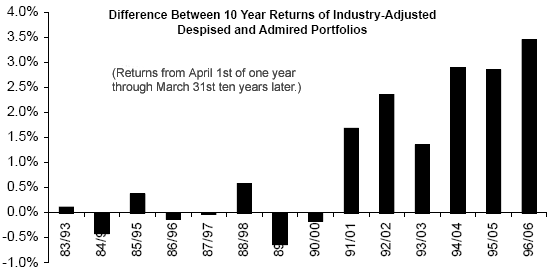Are the most admired companies the best investments? Or, is current state of admiration a contrarian indicator for future returns? In their February 2007 paper entitled “Stocks of Admired Companies and Despised Ones”, Deniz Anginer, Kenneth Fisher and Meir Statman test these hypotheses. The authors define state of admiration using Fortune magazine’s annual survey-based lists of “America’s Most Admired Companies.” Survey respondents are senior executives, directors and securities analysts, and the questions asked seemingly relate indirectly or directly to the investment value of the companies named. Using these lists for April 1983 (survey inception) through March 2006, associated stock return data and a separate survey of high-net worth investors, they conclude that:
- Companies with high Fortune survey scores tend toward larger capitalization, lower book-to-market ratio, lower earning-to-price ratio and higher past stock returns.
- The mean annualized return of the despised (lower half of survey scores, reconstituted annually) portfolio is 17.5%, about 1.8% higher than that of the admired (upper half of survey scores, reconstituted annually) portfolio.
- After adjustment for industry, the mean annualized return of the despised portfolio (17.8%) beats that of the admired portfolio (15.3%) by a larger 2.5%. The Sharpe ratio of the despised is 0.19, beating that of the admired by 0.02. The monthly alpha of the despised is 0.30%, beating that of the admired by by 0.14%.
- Results are consistent with a view that Fortune survey respondents are generally noise traders who believe that good stocks are stocks of good companies, and they pay for this incorrect belief by getting lower returns.
- However, the “despised company effect” is not readily tradable. Relative returns of the stocks of admired and despised companies vary considerably from year to year and even from decade to decade. During 1983-1995, the mean annualized return of the most admired (top 10%) is 9.9% higher than that of the most despised (bottom 10%). But during 1996-2006, the mean annualized return of the the most despised is 9.2% higher than that of the most admired. Overall, during 1983-2006, the mean annualized return of the most despised is 4.0% higher than that of the most admired. Moreover, the effect is not reliably consistent across the spectrum from most admired to most despised.
The following chart, taken from the paper, shows the relative ten-year performance of annually reconstituted portfolios composed of the stocks of despised (lower half of Fortune survey scores) and admired (upper half of Fortune survey scores) companies. It shows that the despised company portfolio has more often outperformed, most notably in decades since 1991.

In summary, the stocks of companies least admired by the ostensibly well-informed may well outperform the stocks of the companies most admired.